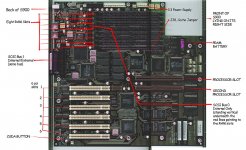Byrd
Well-known member
Hi,
I was reading about the Supermac S900/S910 Mac clones that supported dual CPUs, so in theory you could place your existing CPU in the proprietary secondary slot, and buy another similar CPU for the other slot at a later date for dual CPU support. They recommended you use the same rated CPU, but if you didn't, the hardware automatically determined the shared CPU and bus speed itself. You couldn't mix processor generations, eg. G3 and 604e, some S9x0 models came with a G3 however - so could you add a dual G3 to these?
http://lowendmac.com/supermacs/s900.shtml
http://lowendmac.com/supermacs/dual.shtml
Quite a unique feature for a clone, I especially like the way it adjusts the bus speed on the fly to work with different speed CPUs. Question is, did the dual CPUs acually work with any apps, and does anyone have experience with using this sort of setup?
JB
I was reading about the Supermac S900/S910 Mac clones that supported dual CPUs, so in theory you could place your existing CPU in the proprietary secondary slot, and buy another similar CPU for the other slot at a later date for dual CPU support. They recommended you use the same rated CPU, but if you didn't, the hardware automatically determined the shared CPU and bus speed itself. You couldn't mix processor generations, eg. G3 and 604e, some S9x0 models came with a G3 however - so could you add a dual G3 to these?
http://lowendmac.com/supermacs/s900.shtml
http://lowendmac.com/supermacs/dual.shtml
Quite a unique feature for a clone, I especially like the way it adjusts the bus speed on the fly to work with different speed CPUs. Question is, did the dual CPUs acually work with any apps, and does anyone have experience with using this sort of setup?
JB

